
I’m pretty sure I’m the last person in the cooking-obsessed world to get Sean Brock Fever, the chef behind McCrady’s, Husk, and Minero in Charleston. Worse, this is probably a good time to admit that I was sent his first cookbook, Heritage, when it came out and rejected it on sight alone. There was something about those sleeve tattoos cupping the sacred rainbow beans, an image I’ve seen variations on countless other farm-to-table cookbook covers and magazine spreads, that put me off. Skimming the recipes didn’t always help. Your red peas, cornmeal and gold rice should be from Anson Mills, and if not, at least the cornmeal should be fresh from a gristmill. Your tomatoes should be home-canned, or at the very least, San Marzano. Your pork should be from a heritage pig, your buttermilk and goat cheese should come from a local farm, as should your Red Bliss potatoes; this is your heritage after all.
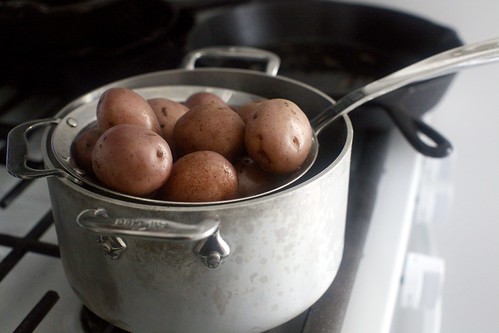
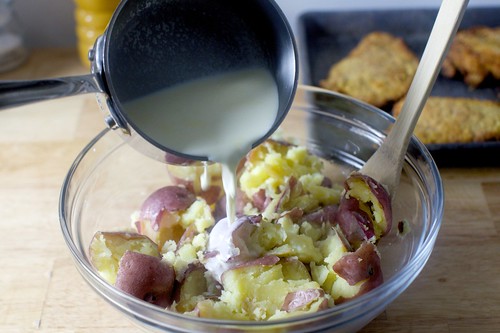
And it’s not that I don’t share the book’s values, either. Like most people, I prefer local humanely raised pork to the feedlot variety. If you haven’t yet, I hope you get a chance to try freshly dug potatoes from a farmers market in a month or two, so you too can be amazed by the depth of flavor atypical of the grocery store variety. I recently bought Anson Mills polenta and grits for the first time, and I’m converted. They’re incredible. They’re fantastically expensive too, as carefully grown food, the best in its class, often is. My grandmother would roll over in her grave if she knew I had used two cups of them just to dredge buttermilk-soaked pork chops (you know, among other concerns there), as the cookbook suggests. I unquestionably believe the world would be a better place if we all had access and the budget for these kinds of ingredients, or if we could all eat Brock’s amazing cooking — James Beard award-winning food that is exclusively indigenous to the South, using heirloom produce and heritage animal breeds — every night. But when it crosses the threshold of my apartment, it’s hard not to be aggressively aware of its gap with the reality I live in, or, as Morrissey once sung to me from a poster on my high school bedroom wall, “it says nothing to me about my life.”
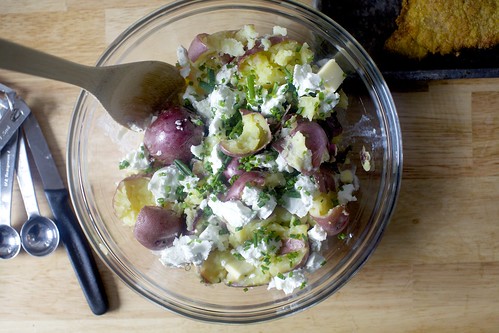
My central question in my daily home cooking is: will this work for me? In my kitchen? With my budget? With the ingredients I have the patience to get on a 25-degree day on foot? In my knee-high rubber boots and dirty winter coat that feels about one sneeze from popping a zipper, hardly the gauzy stuff of farm cookbook covers? To me, the best recipes transcend their ingredients. They make the humdrum ingredients most of us are compromising with in early March magical, not the other way around. These are the recipe stories I hope this site tells.
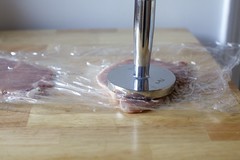
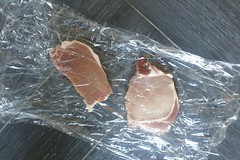

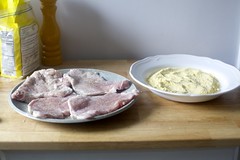
And I’m here to say that if this dish is indicative of the rest of the book, you’re in for a treat. I spied these pork chops early last week after spending 5-plus months having very little interest in meat or cooked vegetables and yet there I was, pining. Panting. Pawing at the book a little, to be honest. It had to happen in my kitchen, and I’m so glad it did.

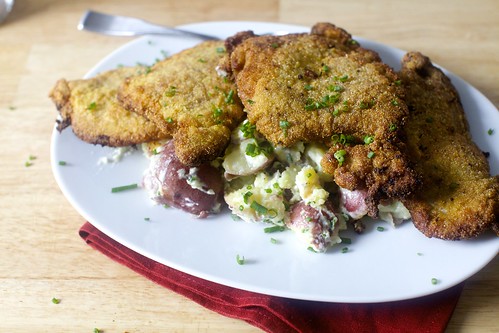
On The Kitchn: I shared the way I organize (or attempt to) my kitchen cabinets, both pantry items and baking pans. And yes, this means I finally took some photos of my new kitchen; more to come over here, if you’re interested.
One year ago: Kale and Quinoa Salad with Ricotta Salata(this would be so good with this meal, yes? or at least as the antidote to it!)
Two years ago: My Favorite Buttermilk Biscuits
Three years ago: Multigrain Apple Crisps
Four years ago: Whole Wheat Goldfish Crackers
Five years ago: Baked Rigatoni with Tiny Meatballs and St. Louis Gooey Butter Cake
Six years ago: Key Lime Coconut Cake and Steak Sandwiches
Seven years ago: Homemade Devil Dog, Ding-Dong or Hostess Cake and Spicy Sweet Potato Wedges
Eight years ago: Two of my favorite Indian recipes: Red Split Lentils With Cabbage and Indian-Spiced Cauliflower and Potatoes
And for the other side of the world:
Six Months Ago: Corn Cheddar and Scallion Strata
1.5 Years Ago: Butterscotch Pudding Popsicles and Pink Lemonade Popsicles
2.5 Years Ago: Vanilla Custards with Roasted Blueberries and Baked Orzo with Eggplant and Mozzarella
3.5 Years Ago: Peach Butter
Cornmeal-Fried Pork Chops and Goat Cheese-Smashed Potatoes
From Heritage by Sean Brock, with a few adjustments
There are several things I like about this recipe. As we’ve talked about before, buttermilk is an excellent, simple, tenderizing marinade. The crust, rather than being that irksome three-strep dredging drudgery (flour, egg wash, crumbs), is just cornmeal, which also makes it gluten-free, and full of crunch. By pounding the chops thin, a 3- or 4-ounce portion feels quite generous, which is wonderful if you’re trying to reduce your meat intake. I might never make mashed potatoes again, not after tasting how good rough-crushed potatoes are scattered with cream, butter and cheese, then half mixed, leaving pockets of each throughout rather than a puree where every bite is like the one before. And while this is a good fit for this wintry mix outside — comforting food, served warm — it’s not as heavy as the stews, soups and braises of February. It looks ahead a little, as we’re all eager to.
Note: You are supposed to soak the chops in buttermilk overnight, or at least four hours, so start now!
Serves 6. We halved this recipe, and wished we hadn’t because leftovers would have been awesome about now.
For the pork chops
6 boneless pork chops (about 3 ounces each)
About 3 cups buttermilk, whole milk if you can find it
Kosher salt and freshly cracked black pepper
2 cups yellow cornmeal
Cayenne pepper
Canola oil (or high heat safflower or sunflower, what I used) for shallow-frying
For the potatoes
3 pounds small-to-medium red potatoes
Kosher salt
1 cup half-and-half (or 1/2 cup milk plus 1/2 cup heavy cream)
6 ounces soft goat cheese
8 tablespoons (1 stick, 4 ounces or 115 grams) unsalted butter, diced and chilled
1/2 cup finely sliced fresh chives
Freshly ground black or white pepper
Marinate the pork chops: Pound each pork chop (using a meat pounder or, in a pinch, I’ve also used a cast iron skillet, rather dramatically) between two pieces of plastic wrap to 1/8-inch thick. Place the chops in a container and cover them with the buttermilk. Cover and marinate at least four hours or overnight or in the refrigerator.
Prep the smashed potatoes: Put the potatoes in a large pot, cover with water and add 1/4 cup salt. Bring the water to a simmer over medium-high heat, reduce the heat to medium-low, and cook the potatoes until fork-tender, about 20 minutes for small potatoes or 30 minutes for medium ones; try not to let the water boil.
Cook the chops: Heat your oven to 200 degrees. Remove the chops from the buttermilk, discarding it and patting most of the buttermilk off the chops. Season the chops with salt and cracked pepper. Put the cornmeal in a shallow bowl and season it with salt and cayenne pepper. Dredge the chops in the cornmeal, gently shaking off the excess, and put on a large plate.
[Brock wants you to cook these in two large cast-iron skillets, using the oil in each only once, discarding it and putting new oil in for the next chop. I used one 12-inch skillet that fit two chops and reused the oil a couple times, but the downside of this is that it will pick up black bits that fall into the oil as it cooks.]Heat a large cast-iron skillet over high heat. When the skillet is hot, add a 1/4-inch of oil to each and heat for 1 minute. Carefully place 2 pork chops in each skillet; do not shake the skillets or touch the chops for 1 minute. Reduce the heat to medium-high and cook the chops until golden brown, about 4 minutes. Carefully turn the chops over and cook until golden brown and crispy on both sides, about 3 to 4 minutes more. I found that my chops really wanted to stick on the second side, so slide a thin spatula underneath them to loosen them from the bottom of the pan before transfer the chops to a baking sheet and keep warm in the oven. Discard the oil the skillet if it gets too murky and repeat with remaining chops.
Finish the potatoes: When the potatoes are almost cooked, bring the half-and-half to a simmer in a small saucepan over medium heat. Drain the potatoes and place them in a large bowl. Using a wooden spoon, carefully smash each potato without breaking it apart. Pour the hot half-and-half over the potatoes; crumble the goat cheese, butter and chives over them then fold it together — I only did this once or twice, preferring to keep as many small pockets of goat cheese throughout as possible. Season with salt, if needed, and white or black pepper.
Serve: The potatoes and chops together. Repeat as soon as possible.
Serve with: Brock recommends that you serve these with a cucumber and pickled green tomato relish, which sounds like everything I want to eat right now, but I would have had to have had 3 1/2 pounds heirloom green tomatoes and gotten started on it two weeks ago (1 week for each pickling stage). I’ll be trying it out this summer. In a pinch, I wish I’d made these pickles instead.
Source: http://feedproxy.google.com/~r/smittenkitchen/~3/fg-A-9tqFzk/